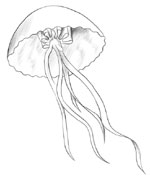Jellyfish “epidemics” are usually cyclical, occurring at specific times during the summer. One day, you are swimming in clear water, and the next day the water is cloudy with floating jellyfish, adrift in the waves. Avoiding jellyfish is the best solution, but sometimes a long tentacle can get you even if the jellyfish body is far away. Symptoms of a jellyfish sting can include: If someone gets stung by a jellyfish, follow these steps to provide first aid for the wound: If the pain is very intense, try rinsing the bite site with some baking soda and water after you’ve followed your first aid steps. It can help decrease the pain until medical help arrives. Even if the sting is mild and the victim feels fine soon after the episode, it’s good to keep watch for up to three days later. Jellyfish stings can get infected days after the incident. The best prevention? Antibacterial ointment—once the stinging sensation is gone. Before then …ouch!
